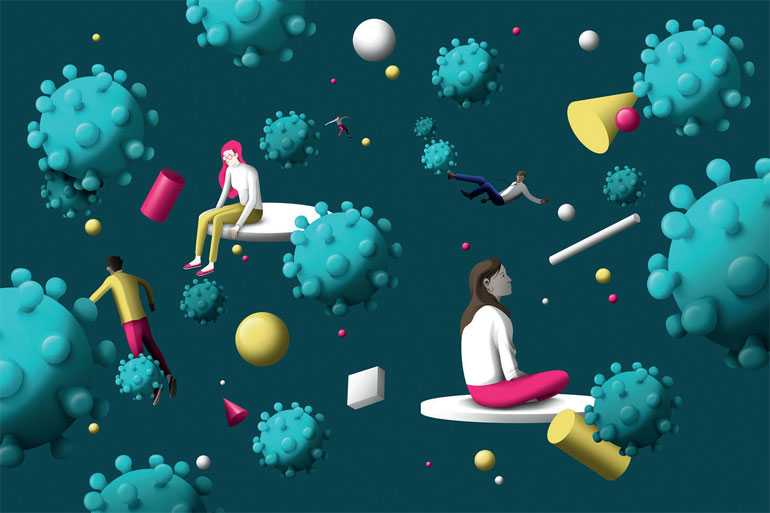Wednesday Dec 10, 2025
Wednesday Dec 10, 2025
Monday, 6 April 2020 00:00 - - {{hitsCtrl.values.hits}}

COVID-19 has become the central stage in our lives creating an impact like the third world war. This war of humanity against nature has shown us multiple lessons in inviting us to be brilliant on basics.
Much has been stated about the gloom and doom of COVID-19. What about the silver lining in the dark cloud? How can we stay safe, sound and serene whilst being confined to home, with a contented mindset? Today’s column is all about seven ups you need to show in order to ensure a serenity upsurge.
 Overview
Overview
“We are in an unprecedented situation and the normal rules no longer apply,” said Antonio Guterres, the UN Secretary General, recently. “We cannot resort to the usual tools in such unusual times. The creativity of the response must match the unique nature of the crisis, and the magnitude of the response must match its scale.” It is a clear invitation to be open minded and to think afresh.
As we are aware, our mind is like a parachute. It works only when it is open. Having the right mindset amidst the current crisis is critical to ensure continuing health and happiness. As the revered religious text the Dhammapada says: “Mano pubbagama dhamma, mano seta manomaya” (mind is the forerunner for success). The story of survival or revival begins with the right mindset. It essentially refers to a person’s world view or the approach towards others.
For the first time in my life, I have been housebound for over a week with meaningful time to read, reflect and relate on multiple perspectives. This was enriched by a couple of opportunities to reach the deserving communities by way of mental and material assistance.
While being in touch with what is going around, it has been a golden opportunity to move “inward bound”. It has been a time not to get disheartened and disappointed, but to be delighted to devote time in “sharpening the saw” by igniting the inner calling. This is the time for us to enhance our physical, mental, emotional and spiritual capacities in order to build a holistic immune system. I would suggest the bundling of the sure-fire path as “seven ups”.
It essentially refers to seven action dimensions. In a nutshell, they are, waking up, shaking up, brushing up, linking up, looking up, growing up, and cheering up. Let’s go into details.
1. Wake Up
It simply invites us to be aware of what’s going on. Slowly but surely, we Sri Lankans are showing the required maturity in facing the devastating COVID-19. The increasingly complex situations we face cannot be approached in a routine manner. Indeed, the quest for creative solutions has become pervasive. It is heartening to Sri Lankan youth coming to the forefront with creative, innovative devices to assist the marathon battle against COVID-19.
Albert Einstein said he owes his creativity to listening to Mozart pieces. Certain songs and compositions allow the brain to be more creative and function better. In the present age the concept of music enhancing your thinking has been scientifically researched and proven. Certain frequencies have a positive effect on increasing your brain’s performance and creativity. Today they are known as Binaural Beats and Isochronic Tones. We need to ignite our innovation as a nation so that cost-effective local solutions such as ICU beds and ventilators will become a definite possibility.
It is all about awakening to new possibilities, new associations, new connections and new results.
2. Shake Up
This is all about challenging the assumptions. One needs to avoid the “quick fix” trap.
Most organisations will acknowledge their need to be more creative, and many will be tempted to pursue the “quick fix” option. Some will, no doubt, claim that they’re satisfied with the degree of success found in the status quo, while failing to realise the long-term benefits of developing a strategy that will ensure an ongoing focus on creativity and innovation to sustain their competitive edge and their very existence. Will your organisation fall into such a trap?
The simple argument here is that conventional thinking will take you only to one point. If you truly want your organisation to make a difference in this world and in the marketplace, then be vigilant in scanning the horizon for new and creative models for doing business. We can invite our colleagues online to create new initiatives that provide positive turning points in the lives of customers.
When more attention is given to the untested and untried and less attention is spent on the routine and status quo, this climate can happen. When such creativity is embraced, the key questions become “What’s new? What’s next? What’s better?”
3. Brush Up
We need to shape ideas, moving them from raw to ripe state. Brainstorming is one powerful tool for this purpose.
The fundamental requirement is to have a brain and it should be in the proper place. You simply can’t sit on it. Start by suspending your judgment and self-criticism, then start writing down related ideas and possible solutions. The goal is to generate as many ideas as possible in a relatively short span of time. Next, focus on clarifying and refining your ideas in order to arrive at the best possible choice.
It reminds me how gems are found and further shined. Ideas also need to be treated with respect and attention. That is the only way to move forward with innovation and implementation.
4. Link Up
“Creativity is just connecting things,” says Steve Jobs. Creative people see connections clearly. They become powerful associations. In fact, creativity acts like the power to connect seemingly unconnected. Using one’s mobile phone to switch on or off the home lights, from far away location is one such example. Connecting digital technology with drama to create wonderful theatrical experience is another.
Another aspect of linking up ideas is to use humour. In humour the storyteller suddenly places us on the side track and immediately we can see our way back to the starting point. In humour the punch line serves as the bridge between the main track and the side track. Edward de Bono, who advocates “lateral thinking” tells us the parallel. We have to devise a practical means for cutting across the tracks. We can do this by using a combination of provocation and movement.
5. Look Up
This is the need for advice and guidance, in a corporate setting. If an employee is not given time or encouragement to be creative and innovative, it can almost certainly be guaranteed that new projects and new mechanisms for their delivery will not be born. Nothing new will happen.
The key word here is encouragement. It depends and hinges on how senior leadership demonstrates their commitment to creativity and innovation. Too often, the atmosphere becomes poisoned by criticism that fosters insecurity, anger and personal agendas with very little consensus building, collaboration or fun. Senior leadership sometimes fails to realise that what they say and do in this context is more powerful than any speech or policy they may make.
Let’s look at in from the point of view of a leader. As a leader, how do you respond to new ideas? What is your reaction to ideas that may not have occurred to you? Are you willing to let other people get the recognition and reward for creativity and innovation? Do you really have a passion for doing the job in new and imaginative ways? Are you willing to change personally to make this happen? Are you willing to put your neck on the line to protect an employee who shows inventiveness and initiative? Are you willing to obligate funding to support creativity and innovation? Do you prefer to judge ideas rather than encourage them or generate them yourself?
The positive answers to the above will determine the looking up will contribute to creativity.
6. Grow Up
Ongoing creative thinking and innovation should be connected into the long-term plans. They should be strategically programmed into every meeting in which managers participate. One may ask, “How many different ways can we look at this issue or problem?” instead of the proverbial “What have we been taught by someone else regarding how to solve this?”
One needs to define broad parameters in which a team is allowed to operate, and then get out of the way. This, in itself allows for true creativity and innovation rather than a regurgitation of what the team thinks the leader wants. It is a case of “hands off” but “eyes open” approach.
What is happening at Google, 3M and many other such creative organisations is to empower dynamic team to grow solutions. We need approaches such as urban agriculture with farming in balconies related to “vertical living”, better supply chain in face of a crisis and to have more reliance on local manufacturing.
7. Cheer Up
When we enjoy a part of the process, we tend to linger in that stage. According to a study published in the Proceedings of the National Academy of Sciences, positive moods can increase your ability to think creatively. As the study says, “If you are doing something that requires you be creative or be in a think tank, you want to be in a place with good mood.” Focus on eliminating negative thoughts or self-criticisms that may impair your ability to develop strong creative skills.
It reminds me of Victor Frankel, the Jewish physician who survived in a Nazi concentration camp. In his best-selling book, ‘Man’s Search for Meaning,’ he shares his horrendous experiences amidst suffering men, yet challenging himself to live each day passionately with a purpose.
“In spite of all the enforced physical and mental primitiveness of the life in a concentration camp, it was possible for spiritual life to deepen. Sensitive people who were used to a rich intellectual life may have suffered much pain (they were often of a delicate constitution), but the damage to their inner selves was less. They were able to retreat from their terrible surroundings to a life of inner riches and spiritual freedom.”
In simple terms, ask the question, “What went right?” as opposed to “What went wrong?” As De Bono tells us, creative thinking is not a mystical talent but a myriad skill that can be practiced and nurtured. We need it more now than any other times.
Way forward
“Vision is not enough. It must be combined with venture. It is not enough to stare up the steps; we must also step up the stairs,” said Vaclav Havel, a former Czech President. In the crucial juncture with COVID-19 creating global havoc, we need to envision a new world with economy blended with humanity and development harmonised with environment.
It should be a swift shift from ‘Ego to Eco’ in encompassing a holistic and an inclusive approach towards sustained results. Perhaps COVID-19 could be the forerunner for a more enlightened world in harmony.
(Prof. Ajantha S. Dharmasiri can be reached through [email protected], [email protected] or www.ajanthadharmasiri.info)